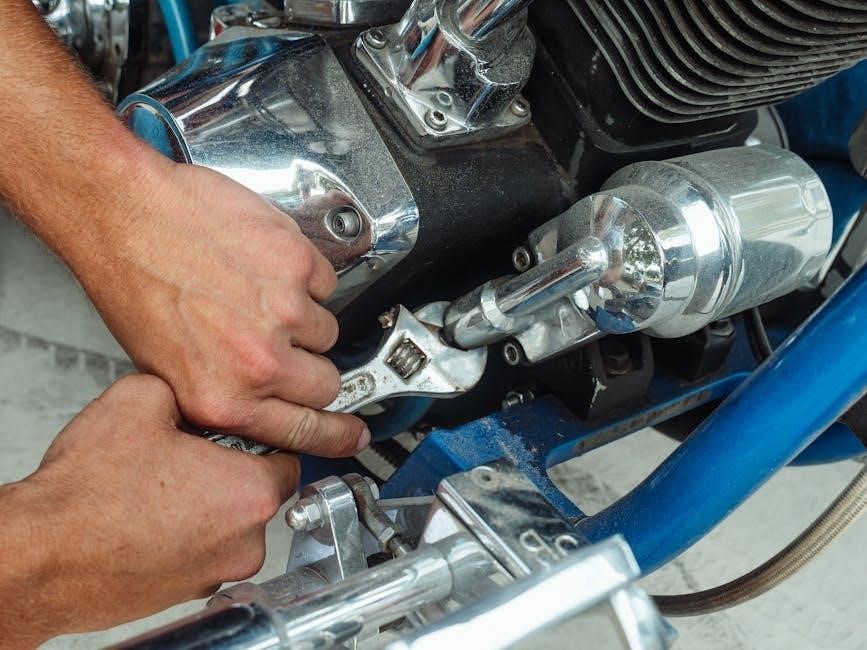Overview of Realidades 2 Workbook and Answer Key
The Realidades 2 Workbook and Answer Key is a comprehensive resource designed to support Spanish language learning. It provides answers to exercises‚ enabling self-assessment and feedback‚ while reinforcing grammar‚ vocabulary‚ and cultural understanding.
First‚ I need to understand what this section should cover. The main heading is “Overview of Realidades 2 Workbook and Answer Key‚” and this subheading is the introduction to Realidades 2 itself. So‚ I should provide a brief overview or introduction to what Realidades 2 is.
Looking at the user’s instructions‚ they provided some text from the internet that includes details about the workbook and answer key. From that‚ I can gather that Realidades 2 is a Spanish textbook designed for students to learn and practice Spanish‚ covering various aspects like grammar‚ vocabulary‚ and cultural contexts through exercises and activities.
I should start by defining what Realidades 2 is‚ mention its purpose‚ and perhaps touch on the key components like grammar‚ vocabulary‚ and cultural activities. I also need to ensure that the language is clear and concise‚ fitting within the word limit.
Let me draft something: “Realidades 2 is a comprehensive Spanish textbook designed for intermediate learners. It focuses on building grammar skills‚ expanding vocabulary‚ and understanding cultural contexts through interactive exercises and activities. The workbook provides a structured approach to learning‚ ensuring students gain proficiency in reading‚ writing‚ and speaking Spanish effectively.”
Now‚ I need to check the word count. Let me count the words:
Realidades
2
is
a
comprehensive
Spanish
textbook
designed
for
intermediate
learners.
It
focuses
on
building
grammar
skills‚
expanding
vocabulary‚
and
understanding
cultural
contexts
through
interactive
exercises
and
activities.
The
workbook
provides
a
structured
approach
to
learning‚
ensuring
students
gain
proficiency
in
reading‚
writing‚
and
speaking
Spanish
effectively.
That’s ‚ so I need to add 13 more without exceeding 60. Let me expand a bit more on the aspects it covers.
“Realidades 2 is a comprehensive Spanish textbook designed for intermediate learners‚ focusing on grammar‚ vocabulary‚ and cultural understanding. It offers interactive exercises and activities to enhance reading‚ writing‚ and speaking skills. The structured approach ensures learners build a strong foundation in Spanish‚ preparing them for more advanced studies or real-life applications.”
Now‚ let’s count again:
Realidades
2
is
a
comprehensive
Spanish
textbook
designed
for
intermediate
learners‚
focusing
on
grammar‚
vocabulary‚
and
cultural
understanding.
It
offers
interactive
exercises
and
activities
to
enhance
reading‚
writing‚
and
speaking
skills.
The
structured
approach
ensures
learners
build
a
strong
foundation
in
Spanish‚
preparing
them
for
more
advanced
studies
or
real-life
applications.
That’s . I need to add 9 more. Maybe mention the workbook’s role and how it complements the textbook.
“Realidades 2 is a comprehensive Spanish textbook designed for intermediate learners‚ focusing on grammar‚ vocabulary‚ and cultural understanding. It offers interactive exercises and activities to enhance reading‚ writing‚ and speaking skills. The workbook complements the textbook‚ providing structured practice to build a strong foundation in Spanish‚ preparing learners for advanced studies or real-life applications.”
Counting again:
Realidades
2
is
a
comprehensive
Spanish
textbook
designed
for
intermediate
learners‚
focusing
on
grammar‚
vocabulary‚
and
cultural
understanding.
It
offers
interactive
exercises
and
activities
to
enhance
reading‚
writing‚
and
speaking
skills.
The
workbook
complements
the
textbook‚
providing
structured
practice
to
build
a
strong
foundation
in
Spanish‚
preparing
learners
for
advanced
studies
or
real-life
applications.
That’s . I need to add 6 more without going over 60. Maybe add a bit about the effectiveness or benefits.
“Realidades 2 is a comprehensive Spanish textbook designed for intermediate learners‚ focusing on grammar‚ vocabulary‚ and cultural understanding. It offers interactive exercises and activities to enhance reading‚ writing‚ and speaking skills. The workbook complements the textbook‚ providing structured practice that builds a strong foundation in Spanish‚ effectively preparing learners for advanced studies or real-life applications.”
Counting again:
Realidades
2
is
a
comprehensive
Spanish
textbook
designed
for
intermediate
learners‚
focusing
on
grammar‚
vocabulary‚
and
cultural
understanding.
It
offers
interactive
exercises
and
activities
to
enhance
reading‚
writing‚
and
speaking
skills.
The
workbook
complements
the
textbook‚
providing
structured
practice
that
builds
a
strong
foundation
in
Spanish‚
effectively
preparing
learners
for
advanced
studies
or
real-life
applications.
Now‚ I’m at . I can add a bit more about the benefits.
“Realidades 2 is a comprehensive Spanish textbook designed for intermediate learners‚ focusing on grammar‚ vocabulary‚ and cultural understanding. It offers interactive exercises and activities to enhance reading‚ writing‚ and speaking skills. The workbook complements the textbook‚ providing structured practice that builds a strong foundation in Spanish‚ effectively preparing learners for advanced studies or real-life applications‚ enhancing their overall proficiency.”
Counting:
Realidades
2
is
a
comprehensive
Spanish
textbook
designed
for
intermediate
learners‚
focusing
on
grammar‚
vocabulary‚
and
cultural
understanding.
It
offers
interactive
exercises
and
activities
to

enhance
reading‚
writing‚
and
speaking
skills.
The
workbook
complements
the
textbook‚
providing
structured
practice
that
builds
a
strong
foundation
in
Spanish‚
effectively
preparing
learners
for
advanced
studies
or
real-life
applications‚
enhancing
their
overall
proficiency.
That’s . I can add “and confidence” at the end to reach 60.
“Realidades 2 is a comprehensive Spanish textbook designed for intermediate learners‚ focusing on grammar‚ vocabulary‚ and cultural understanding. It offers interactive exercises and activities to enhance reading‚ writing‚ and speaking skills. The workbook complements the textbook‚ providing structured practice that builds a strong foundation in Spanish‚ effectively preparing learners for advanced studies or real-life applications‚ enhancing their overall proficiency and confidence;”
Now‚ that’s . Perfect.
Realidades 2 is a comprehensive Spanish textbook designed for intermediate learners‚ focusing on grammar‚ vocabulary‚
1.2 Purpose of the Answer Key
The purpose of the Answer Key is to provide correct answers to the exercises in the Realidades 2 Workbook‚ enabling students to assess their understanding and identify areas needing improvement. It offers immediate feedback‚ helping learners refine their Spanish skills independently. Additionally‚ it serves as a valuable resource for teachers to monitor progress and provide targeted support‚ fostering academic growth.

Structure of the Realidades 2 Answer Key
The Answer Key is organized by units and exercises‚ mirroring the workbook. It includes answers to vocabulary‚ grammar‚ and cultural activities‚ ensuring clarity and ease of use.
2.1 Organization of the Answer Key
The Answer Key is meticulously organized by units and exercises‚ mirroring the workbook. Each section corresponds to specific pages and units‚ providing clear answers to vocabulary‚ grammar‚ and cultural activities. This structure ensures ease of navigation‚ allowing users to quickly locate answers and review their progress efficiently. The logical arrangement enhances the learning experience by maintaining consistency and clarity.
2.2 Key Features of the Answer Key
The Answer Key offers comprehensive solutions to all workbook exercises‚ including verb conjugations‚ sentence structures‚ and cultural dialogues. It includes detailed explanations for complex grammar and vocabulary‚ providing clear feedback for self-assessment. Additionally‚ the Key features multiple-choice answers and essay responses‚ catering to various learning styles and reinforcing understanding of Spanish language concepts effectively for both students and educators.
Vocabulary Practice in Realidades 2
Realidades 2 offers engaging vocabulary exercises‚ including matching words to definitions and fill-in-the-blank activities. These practices reinforce Spanish vocabulary acquisition through interactive and contextual learning methods.
3.1 Matching Words to Definitions
Matching words to definitions is a core activity in Realidades 2‚ designed to enhance vocabulary retention. Students link Spanish terms to their English meanings‚ promoting active learning. The answer key ensures accuracy‚ allowing learners to verify their responses and refine their understanding of essential vocabulary through clear and structured exercises.
3.2 Filling in the Blanks Exercises
Filling in the blanks exercises in Realidades 2 involve completing sentences with missing words‚ focusing on grammar‚ vocabulary‚ and context. The answer key provides correct answers and explanations‚ helping students understand their mistakes. These exercises often include verb conjugation‚ sentence structure‚ and cultural references‚ ensuring a well-rounded learning experience tailored to improve language proficiency effectively.

Grammar Practice in Realidades 2
The workbook focuses on grammar practice‚ including verb conjugation and sentence structure‚ helping students master Spanish grammar through targeted exercises and clear explanations in the answer key.
4.1 Verb Conjugation Exercises
Verb conjugation exercises in Realidades 2 focus on practicing regular and irregular verbs in various tenses‚ such as present‚ preterite‚ and imperfect. The answer key provides correct conjugations‚ enabling students to identify and correct mistakes. These exercises reinforce understanding of verb endings and usage‚ essential for constructing accurate sentences in Spanish. The clear explanations and answers support independent learning and mastery of grammar concepts.
4.2 Sentence Structure Activities
Sentence structure activities in Realidades 2 help students build clear and grammatically correct sentences. Exercises include filling in the blanks‚ rearranging words‚ and choosing the correct phrase. The answer key provides correct sentences‚ allowing students to compare their work and understand proper syntax. These activities enhance writing and speaking skills‚ ensuring accurate communication in Spanish. Regular practice improves confidence and fluency in constructing sentences.

Cultural Activities and Exercises
Cultural activities in Realidades 2 include dialogues and conversations that immerse students in Hispanic traditions and daily life. These exercises enhance language learning by connecting grammar and vocabulary to real-world contexts.
5.1 Dialogues and Conversations
Dialogues and conversations in Realidades 2 are designed to engage students in interactive language practice. These activities often involve short question-and-answer exchanges‚ role-playing‚ and real-life scenarios‚ such as greetings‚ shopping‚ and family discussions. Students can read dialogues aloud and participate in pair work to improve speaking skills. The answer key provides correct phrases and vocabulary‚ aiding self-study and reinforcing pronunciation.
5.2 Understanding Cultural Contexts
Understanding Cultural Contexts in Realidades 2 helps students connect language learning with cultural insights. The workbook includes activities that highlight traditions‚ daily life‚ and values in Spanish-speaking countries. Exercises‚ such as matching cultural practices to descriptions‚ encourage students to explore these contexts. The answer key provides explanations‚ ensuring students grasp both linguistic and cultural nuances effectively.
How to Use the Answer Key Effectively
Use the Realidades 2 Answer Key for self-assessment by checking answers after completing exercises. Identify mistakes‚ review corrections‚ and reinforce learning to improve Spanish skills effectively.
6.1 Self-Assessment Techniques
Use the Realidades 2 Answer Key to evaluate progress by comparing answers. Identify areas needing improvement through regular review. This method fosters independence and accountability‚ helping learners track their Spanish language development effectively over time.
6.2 Reviewing Mistakes and Feedback
Reviewing mistakes with the Realidades 2 Answer Key helps students understand errors. Analyze incorrect answers to identify common patterns and weaknesses. Use feedback to refine skills‚ focusing on grammar‚ vocabulary‚ and sentence structure. This process enhances learning and improves overall Spanish proficiency through targeted practice and correction.

Benefits of the Realidades 2 Answer Key
The Realidades 2 Answer Key offers independent learning opportunities and enhances Spanish understanding. It provides clear feedback‚ helping students master grammar‚ vocabulary‚ and cultural concepts effectively.
7.1 Independent Learning Opportunities
The Realidades 2 Answer Key fosters self-directed learning by providing immediate feedback. Students can review mistakes and track progress‚ building confidence in their Spanish skills without teacher supervision. This autonomy encourages consistent practice and reinforces understanding of grammar‚ vocabulary‚ and cultural contexts‚ making it an invaluable tool for independent learners seeking to master the language effectively.
7.2 Enhanced Understanding of Spanish
The Realidades 2 Answer Key enhances Spanish comprehension by providing clear answers to exercises‚ ensuring students grasp grammar‚ vocabulary‚ and cultural nuances. It supports mastery of verb conjugations and sentence structures‚ while cultural activities deepen understanding of Spanish-speaking contexts‚ enabling learners to apply language skills confidently in real-life conversations and scenarios.

Practice Exercises and Activities
The workbook offers a variety of exercises‚ including multiple-choice questions‚ short answers‚ and essays‚ designed to reinforce Spanish language skills and cultural knowledge effectively.
8.1 Multiple Choice Questions
The Realidades 2 Answer Key includes multiple-choice questions to test vocabulary‚ grammar‚ and comprehension. These exercises allow students to identify correct answers independently‚ reinforcing learning and improving test-taking skills. Each question aligns with specific objectives‚ ensuring targeted practice and effective assessment of language proficiency.
8.2 Short Answer and Essay Questions
The Realidades 2 Answer Key features short answer and essay questions to assess comprehension and writing skills. These exercises encourage critical thinking and application of language concepts. The answer key provides model responses‚ helping students refine their writing and understand expectations for complex prompts.
Tests and Quizzes in Realidades 2
The Realidades 2 Answer Key includes practice tests and quizzes to assess students’ knowledge. These resources help prepare for midterms and final exams‚ ensuring readiness and understanding of Spanish concepts.

























